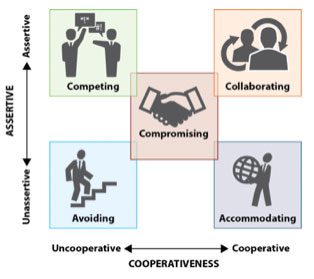 People deal with conflict in a variety of ways, therefore you need different conflict resolution strategies.
People deal with conflict in a variety of ways, therefore you need different conflict resolution strategies.
We at Participation Company spend a lot of time talking about conflict resolution through active listening and training people to resolve conflict using a variety of strategies. This is how the Thomas-Kilmann measurement instrument and their five conflict resolution strategies came to our attention.
Kenneth Thomas and Ralph Kilmann developed five conflict resolution strategies that people use to handle conflict, including avoiding, defeating, compromising, accommodating, and collaborating.
This is based on the assumption that people choose how cooperative and how assertive to be in a conflict. It suggests that everyone has preferred ways of responding to conflict, but most of us use all methods under various circumstances. It is helpful to understand the five methods, particularly when you want to move a group forward.
Conflict Resolution Strategy #1: Avoiding
Avoiding is when people just ignore or withdraw from the conflict. They choose this method when the discomfort of confrontation exceeds the potential reward of resolution of the conflict. While this might seem easy to accommodate for the facilitator, people aren’t really contributing anything of value to the conversation and may be withholding worthwhile ideas. When conflict is avoided, nothing is resolved.
Conflict Resolution Strategy #2: Competing
Competing is used by people who go into a conflict planning to win. They’re assertive and not cooperative. This method is characterized by the assumption that one side wins and everyone else loses. It doesn’t allow room for diverse perspectives into a well informed total picture. Competing might work in sports or war, but it’s rarely a good strategy for group problem solving.
Debra wrote an illuminating article on how conflict resolution failure can lead to revolution. It’s what can happen when people feel like they aren’t being listened to and start being assertive.
Conflict Resolution Strategy #3: Accommodating
Accommodating is a strategy where one party gives in to the wishes or demands of another. They’re being cooperative but not assertive. This may appear to be a gracious way to give in when one figures out s/he has been wrong about an argument. It’s less helpful when one party accommodates another merely to preserve harmony or to avoid disruption. Like avoidance, it can result in unresolved issues. Too much accommodation can result in groups where the most assertive parties commandeer the process and take control of most conversations.
Conflict Resolution Strategy #4: Collaborating
Collaborating is the method used when people are both assertive and cooperative. A group may learn to allow each participant to make a contribution with the possibility of co-creating a shared solution that everyone can support.
A great way to collaborate and overcome conflict is to reach out and touch them.
Conflict Resolution Strategy #5: Compromising
Another strategy is compromising, where participants are partially assertive and cooperative. The concept is that everyone gives up a little bit of what they want, and no one gets everything they want. The perception of the best outcome when working by compromise is that which “splits the difference.” Compromise is perceived as being fair, even if no one is particularly happy with the final outcome.
You can learn more about the Thomas-Kilmann Instrument on their website here.
Are you having trouble getting your group to participate in the conflict resolution discussion? Here is The Participation Company’s own Skill Sheet on the Seven Sins Leading to Anti-Participation, free for immediate download:
[button link=”https://theparticipationcompany.com/wp-content/uploads/2021/01/Skill-sheet-7-Sins.pdf” size=”medium” target=”_blank” icon=”” color=”alternative-1″ lightbox=””]Download TPC’s Skill Sheet on Anti-Participation[/button]
We use Skill Sheets like this one in our training sessions. If you’d like to know more, please check them out now.
We have also written several other articles on conflict resolution strategies. Looking for something specific? Send us your questions!

I am happy to use this information in helping my family members to deal in a satisfactorily manner with conflicts
This is great. What is the best conflict resolution strategy for conflicting parties who think that each one of them is right and does not want to collaborate or calm down?
Thanks for the information
perfect
I am really happy for the guidelines at least i can say that am not obsessed with emotions
I’m a family/divorce mediator with 7 years of experience – I’ve found this site to be truly beneficial to furthering the goals of conflict resolution and problem solving. Great Job!
Pingback: How To Run A Successful Partnership - amabusinessguy
Pingback: CASE STUDY ANALYSIS ON KAY AND ROBERT – MATHILDA'S
Pingback: Case Study Analysis – Daryl's Blog